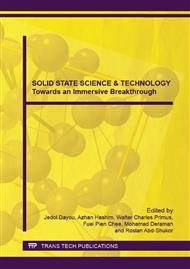p.3
p.9
p.14
p.20
p.27
p.32
p.38
p.45
The Effect of CuO on NiO Electroceramics
Abstract:
The Ni1-xCuxO was prepared from raw materials of NiO and CuO via solid state reaction. This study was focuses on undoped and CuO doped NiO properties. CuO was used as dopant with five different concentrations. The powders were mix for 24 hours and followed by calcinations at 900°C for 2 hours. The calcined powders were compacted to a 5 mm diameter pellet form, by applying 200 MPa pressure. Then, the pellets were sintered at temperature 1200°C for 12 hours. After that, the samples were analyzed by using XRay diffraction (XRD) in order to identify the phase formation, scanning electron microscopy (SEM) for the microstructure and surface topography observation, density measurement by Archimedes principle and impedance analyzer in order to measure the dielectric properties. XRD results show that all sintered pellets produce a single phase of Ni1-xCuxO. In addition, increase of Cu dopant concentration causes the lattice parameter getting larger. Apart from that, SEM shows that more addition of Cu dopant increase the grain size. The density is also improved, due to formation of bigger grain size lead to an increasing in density. Impedance analyzer results show the dielectric behaviour of the samples was improved with increasing of CuO content. The 0.10 mol% CuO obtained optimum dielectric properties with lowest dielectric loss measured at 1 GHz (0.008).
Info:
Periodical:
Pages:
3-8
Citation:
Online since:
June 2015
Keywords:
Price:
Сopyright:
© 2015 Trans Tech Publications Ltd. All Rights Reserved
Share:
Citation:


